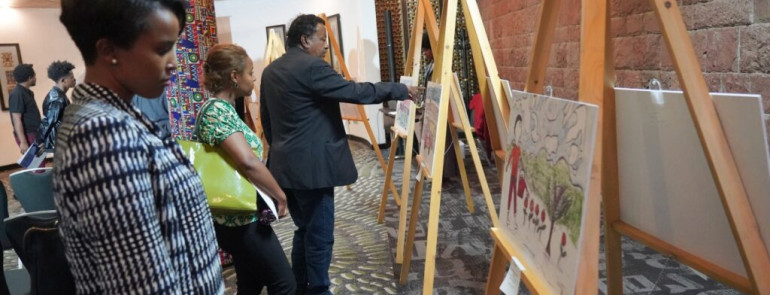In the wake of conflict, the scars often run deep, especially for children. Witnessing violence and displacement can leave a lasting impact on their mental well-being. However, in Ethiopia’s Amhara, Afar, and Tigray regions, art emerged as a powerful tool for healing and hope. The USAID-sponsored “Brighter Futures” Art Exhibition, held in Addis Ababa from January 23rd to 29th, 2024, showcased the remarkable work of children who participated in art therapy programs.
This wasn’t just an exhibition of artistic talent; it was a testament to the resilience of the human spirit, particularly in children. The program, implemented as part of the READ II Education Recovery Activity, aimed to address the psychological impact of conflict on students in Internally Displaced Persons (IDP) camps, host communities, and affected schools.

Art as Therapy: A Path to Healing
Art therapy is a well-established form of psychotherapy that utilizes creative expression to explore emotions and experiences. For children affected by conflict, art therapy provides a safe space to express their feelings in a way that words might not be able to capture. Through drawing, painting, and other creative mediums, children can process their trauma, build self-esteem, and develop coping mechanisms.
The “Brighter Futures” program, launched in early 2022, reached nearly 11,000 fourth and fifth graders across 156 schools. Collaborating with instructors from Regional Colleges of Teacher Education, the program incorporated art therapy sessions into the curriculum. These sessions provided a platform for children to explore their experiences, develop their artistic talents, and find solace in creative expression.

Beyond the Exhibition: A Brighter Future
The “Brighter Futures” Art Exhibition wasn’t a one-off event. It served as a culmination of the eight-month-long art therapy program and a springboard for future initiatives. The success of the program highlights the importance of integrating mental health support into education programs, especially in regions affected by conflict.
The exhibition garnered significant attention, attracting government officials, representatives from international organizations, and prominent figures from the Ethiopian art community. This exposure helped raise awareness about the mental health needs of children in conflict zones and the effectiveness of art therapy in addressing those needs.
The program also aimed to empower educators with the tools and techniques to incorporate art therapy into their teaching practices. Equipping teachers with these skills can ensure that the benefits of art therapy extend beyond the program and reach countless more children in the long run.
The “Brighter Futures” Art Exhibition showcased the transformative power of art therapy. By offering children a safe space to express themselves creatively, the program helped them navigate their emotions, build resilience, and envision a brighter future.
The success of this initiative paves the way for future programs that integrate art therapy and mental health support into education systems in conflict-affected regions. By investing in the well-being of children, we can empower them to heal, learn, and thrive, contributing to a more peaceful and hopeful future for Ethiopia and other countries facing similar challenges.
This blog post only scratches the surface of the “Brighter Futures” Art Exhibition’s significance. Further research can explore the specific art therapy techniques employed in the program, the long-term impact on the participating children, and the potential for scaling up this program to reach even more children in need.
The exhibition serves as a powerful reminder that even amidst darkness, there is always hope. Through creative expression and the support of dedicated programs, children can find healing and pave the way for a brighter future.

